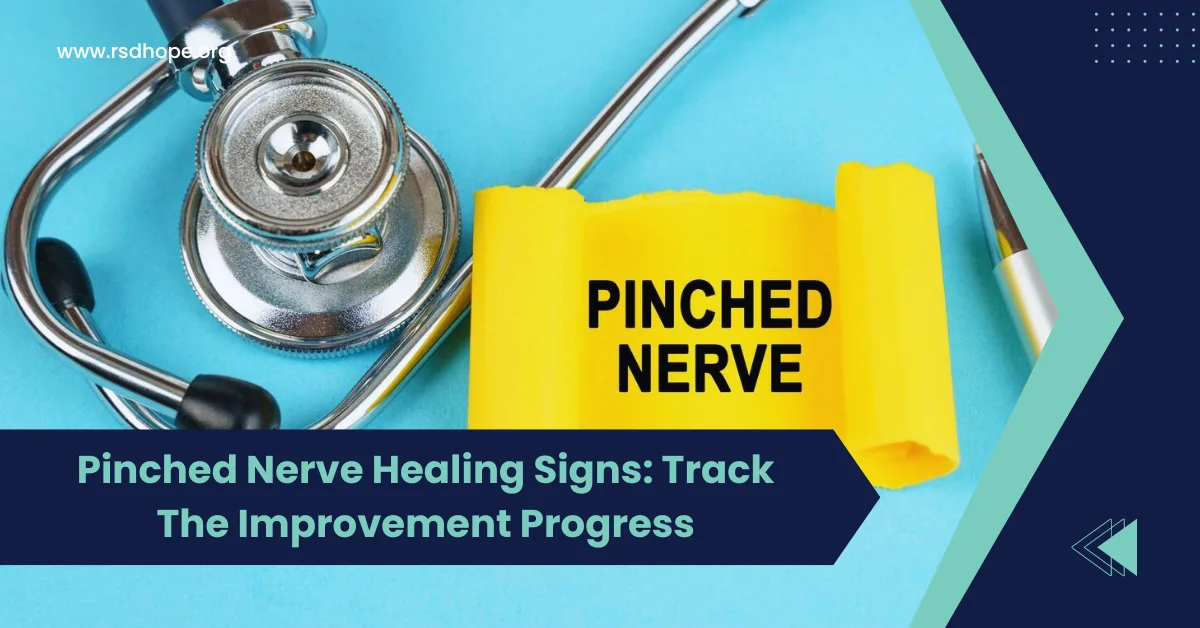A pinched nerve occurs when excessive pressure is applied to a nerve by surrounding tissues, bones, cartilage, muscles, or tendons. This pressure disrupts the nerve’s function, causing pain, numbness, tingling, and weakness in the affected area.
Pinched nerves can happen anywhere in the body, and the symptoms vary depending on the location and severity of the compression. In this comprehensive guide, we’ll delve into the stages of pinched nerve healing and the signs that indicate your nerve is on the mend.
Key Takeaways
- Pinched nerves cause pain, numbness, tingling, and weakness due to compression by surrounding tissues.
- Healing stages include inflammation, rest, and gradual improvement of symptoms.
- Signs of healing include reduced pain, improved mobility, and decreased numbness or tingling.
What is a Pinched Nerve and How Does It Feel?
When a nerve is compressed or pinched, it cannot function properly, leading to various uncomfortable sensations. The pressure on the nerve disrupts the normal transmission of signals between the brain and the affected body part. This disruption can cause pain, numbness, tingling, burning, or weakness in the area served by the pinched nerve. The severity of these symptoms depends on the degree and duration of the nerve compression.
Also Read: What Is Infraspinatus Pain: Causes, Symptoms And Treatments
Types of Pinched Nerves
Pinched nerves can occur in different areas of the body, each with its own set of symptoms and challenges. Some common types include:
- Cervical Radiculopathy (pinched nerve in the neck): Causes pain, numbness, or weakness in the neck, shoulders, arms, or hands.
- Lumbar Radiculopathy (pinched nerve in the lower back): Leads to pain, numbness, or weakness in the lower back, legs, or feet.
- Carpal Tunnel Syndrome (pinched nerve in the wrist): Results in pain, numbness, or tingling in the hand and fingers.
- Peroneal Neuropathy (pinched nerve in the leg): Causes weakness, numbness, or tingling in the foot or lower leg.
Stages of Pinched Nerve Healing
The healing process of a pinched nerve typically involves three stages:
- Inflammation Stage: During this initial stage, the affected area may be swollen, tender, and painful. Rest and anti-inflammatory treatments are crucial to reduce inflammation and prevent further damage.
- Rest and Healing Stage: As the inflammation subsides, the nerve begins to heal. It’s essential to maintain proper posture, avoid aggravating activities, and allow the body to repair itself during this stage.
- Recovery Stage: Gradually, the pain and other symptoms start to diminish as the nerve heals and normal function is restored. Physical therapy and gentle exercises can help strengthen the surrounding muscles and prevent future incidents.
Pinched Nerve Healing Signs
Several signs indicate that your pinched nerve is healing:
- Reduced Pain: As the nerve heals, you may experience a gradual decrease in pain intensity. Sharp, shooting pains may subside, replaced by a dull ache or occasional twinges.
- Improved Mobility: You may find it easier to move the affected area without discomfort. Stiffness and limited range of motion should improve as the nerve heals.
- Decreased Numbness or Tingling: The numbness, tingling, or “pins and needles” sensation in the affected area should diminish over time as the nerve function is restored.
- Increased Strength: Weakness caused by the pinched nerve should gradually improve, allowing you to regain strength in the affected muscles.
It’s essential to remember that everyone’s healing process is unique, and the timeline for recovery varies depending on the severity of the pinched nerve and individual factors.
Treatment Options for a Pinched Nerve
Treatment for a pinched nerve focuses on relieving pressure and allowing the nerve to heal. Conservative treatment options include:
- Rest and Activity Modification: Avoid activities that aggravate the pinched nerve and allow the affected area to rest.
- Physical Therapy: Gentle stretching, exercises, and manual therapy techniques can help alleviate pressure on the nerve and strengthen surrounding muscles.
- Pain Management: Over-the-counter pain relievers, such as ibuprofen or acetaminophen, can help manage pain and inflammation. In some cases, prescription medications or injections may be necessary.
- Ergonomic Adjustments: Modifying your workspace, using proper posture, and employing ergonomic devices can help prevent and alleviate pinched nerves.
In severe cases or when conservative treatments fail, surgical intervention may be necessary to relieve the pressure on the nerve.
Conclusion
Pinched nerves can cause significant discomfort and limit daily activities, but with proper care and treatment, most cases heal effectively. By understanding the stages of pinched nerve healing and recognizing the signs of improvement, you can work with your healthcare provider to develop an appropriate treatment plan.
If you suspect you have a pinched nerve, don’t hesitate to seek medical advice to ensure a proper diagnosis and timely treatment. With patience, self-care, and the right approach, you can overcome the challenges of a pinched nerve and regain your quality of life.
Also Read: Best Vitamins For Sciatica Nerve Pain: Boost Your Healing Journey
FAQs
A: The healing time for a pinched nerve varies depending on the severity and location of the compression. Mild cases may resolve within a few days to weeks, while more severe cases can take several weeks or months.
A: Yes, many cases of pinched nerves can heal on their own with rest, activity modification, and conservative treatments. However, if symptoms persist or worsen, it’s essential to consult a healthcare professional.
A: If left untreated, a pinched nerve can lead to chronic pain, permanent nerve damage, and muscle weakness. In severe cases, it may cause loss of sensation or paralysis in the affected area.
A: It’s best to avoid activities that aggravate the pinched nerve and allow the affected area to rest. Gentle stretching and low-impact exercises may be beneficial, but it’s crucial to consult with a healthcare provider or physical therapist for guidance.
Sources:
- American Academy of Orthopaedic Surgeons. (2021). Cervical Radiculopathy (Pinched Nerve). Retrieved from https://orthoinfo.aaos.org/en/diseases–conditions/cervical-radiculopathy-pinched-nerve/

